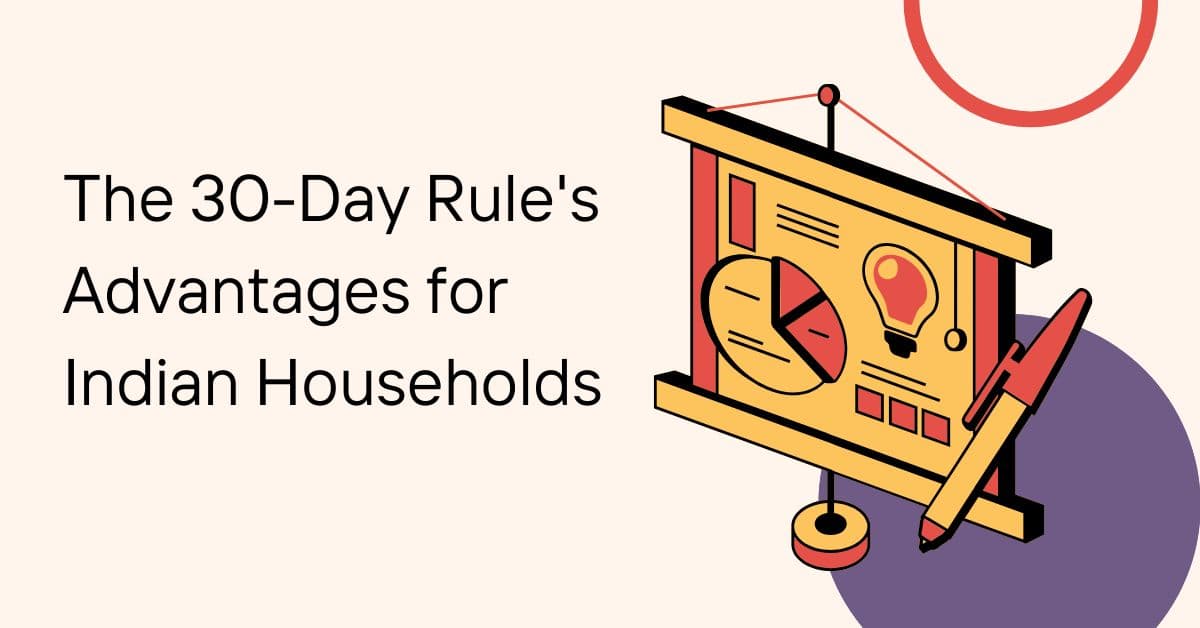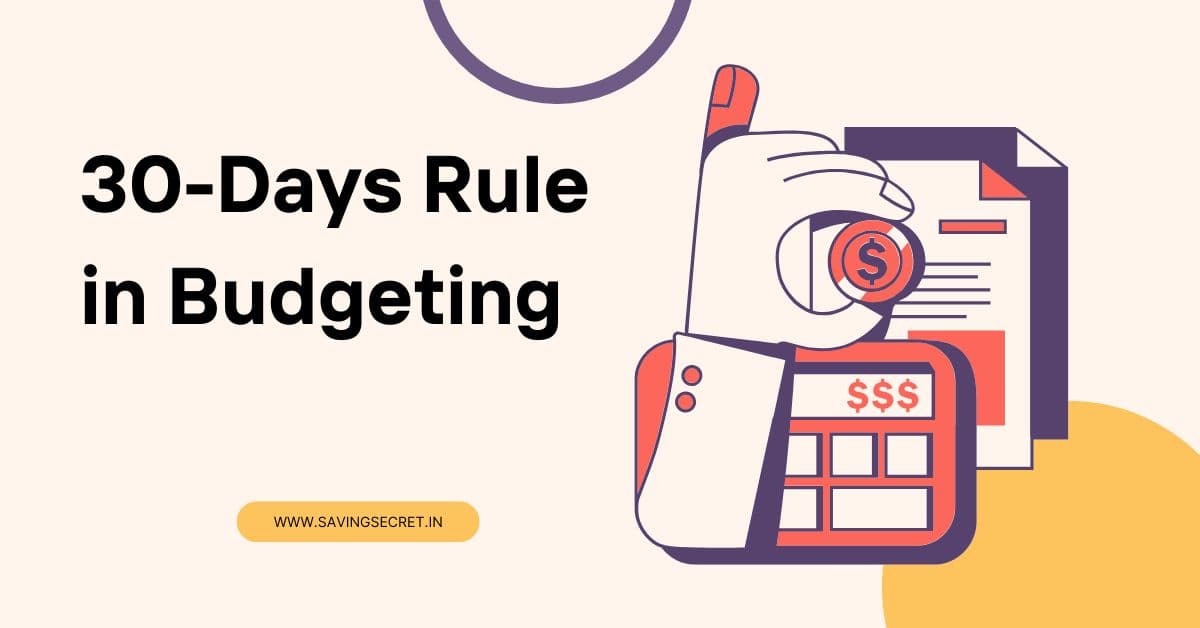30-Days Rule in Budgeting: In India, handling finances may be like walking a tightrope. It’s no wonder that many of us find it difficult to stay within our budgets given the rise in inflation, the ubiquity of internet shopping, and the cultural appeal of occasions like weddings and Diwali. However, what if there was an easy way to increase savings and reduce excessive spending without feeling deprived? The 30-Days Rule in Budgeting is a potent yet simple technique that is revolutionising the way Indians handle their money. The 30-Days Rule is explained in detail in this extensive tutorial, along with how it operates, why it’s ideal for India, and how you can begin using it right now to develop more frugal spending practices.
What is the 30-Days Rule for Budgeting?
The 30-Days Rule is essentially a personal finance tip intended to address impulsive purchasing. The basic concept is to wait 30 days before making a purchase when you’re tempted to buy something unnecessary, like a new smartphone, a set of earrings, or even a luxury supper. Review your choice after this cooling-off time. Go ahead and buy the item if it still seems required and falls inside your budget. Usually, you’ll discover that the desire has subsided, sparing you money and heartache.

By allowing your brain time to recover from the emotional high of desire, this rule takes advantage of human nature. In a nation like India, where flash sales and discounts are commonplace due to e-commerce sites like Flipkart, Amazon, and Myntra, the 30-Days Rule serves as a financial filter, keeping necessities and desires apart.
Why the 30-Day Rule is a Game-Changer in India
India has a unique financial environment. Spending is ingrained in our everyday lives due to a thriving population, a developing middle class, and an economy that combines modernity and tradition. There is a lot of pressure to spend, whether it’s to meet social standards or indulge during holiday seasons. The 30-Days Rule is especially pertinent to Indians for the following reasons:
- Festive Spending Frenzy: India enjoys a lot of festivals, including Christmas, Eid, Holi, and Diwali, and with them come sales like the Great Indian Festival and the Big Billion Days. By following the 30-Days Rule, you may steer clear of purchases that you’ll regret by January.
- Inflation and Growing Costs: Every rupee saved on non-essentials contributes to financial security as the price of food, petrol and rent continues to rise.
- Digital Temptations: Impulse purchase is now simpler than ever because to the growth of UPI payments, “Buy Now, Pay Later” alternatives, and influencer-driven marketing. This regulation prevents thoughtless swipes.
- Culture of Savings: The 30-Days Rule is in line with India’s long-standing belief in saving for the future, which is ideal for families in Tier-2 cities like Jaipur and Lucknow or young professionals in metro areas like Mumbai, Delhi, and Bangalore.
Using this budgeting method can help you develop a deliberate spending attitude in addition to reducing expenses.
How to Apply the 30-Day Rule to Your Own Life
Are you prepared to try the 30-Days Rule? You wouldn’t believe how simple it is. This is a detailed handbook designed for Indian lifestyles:
Step 1: Identify the Impulse
Recognising when you’re going to make an impulsive buy is the first step. Perhaps it’s an IPL-season gizmo or a lehenga you saw on Instagram. “Is this a need or a want?” ask yourself after a moment.
Step 3: Make a waiting list
In a journal, spreadsheet, or budgeting tool, write the item, its price, and the date. Apps like Moneyview, Walnut, or even Google Keep are excellent for digitally monitoring these inclinations in India.
Step 4: Re-evaluate Your Choice
Check in with yourself at the end of the thirty days. Are you still interested in the item? Have other priorities arisen, or has your pay cheque arrived? You’ll frequently discover that the item is no longer worth it.
Step 5: Use the Savings in Another Way
Don’t let the money sit around if you decide not to make the transaction. Invest it in a mutual fund SIP, recurring deposit, or savings account. With careful saving, even little sums, like ₹500 or ₹1,000, may increase over time.
The 30-Day Rule’s Advantages for Indian Households
Choosing “no” to spending is only one aspect of the 30-Days Rule; another is choosing “yes” to financial independence. This is how it helps you:

- Reduces Impulse Spending: Studies reveal that impulsive purchases make up a sizeable portion of India’s discretionary income. You can get that money back with the aid of this rule.
- Promotes Mindfulness: It teaches you to be mindful of every rupee you spend, which is in line with India’s tradition of thrift.
- Reduces Clutter: Small homes in places like Mumbai or Kolkata are ideal for this since less impulsive purchases translate into less things accumulating at home.
- Enhances Long-Term Objectives: The savings mount quickly, whether you’re using them to pay for a child’s school, purchase a scooter, or save emergency funds.
- Festive Season Saviour: This guideline makes sure you don’t spend too much money on unnecessary purchases during months when spending is at its highest.
An Actual Success Story: Rohan’s ₹50,000 Savings
Rohan, a marketing manager from Pune who is 32 years old, used to spend a lot of money on electronics and eating out. “I wouldn’t think twice about buying earbuds or a smartwatch when I saw a sale on Flipkart,” he explains. He chose to give the 30-Days Rule a try after discovering it online. He did not purchase a ₹10,000 game console within his first month. He saved ₹50,000 over the course of six months, which was sufficient to pay off a portion of his two-wheeler debt.
Millions of Indians who balance EMIs, family obligations, and personal preferences can identify with Rohan’s experience. The 30-Days Rule promotes empowerment via choice rather than sacrifice.
Adapting the 30-Day Rule to India: Useful Advice
Try these suggestions to ensure that this budgeting approach functions flawlessly in the Indian context:
- Beat the Sale Hype: Make a list of things you’re tempted by and wait 30 days during Myntra’s End of Reason Sale or Amazon’s Great Indian Sale. Another sale is probably on the horizon.
- Leverage Cashback: Rather of using your cashback to buy additional items, put it into your savings if you receive it from applications like Paytm or PhonePe.
- Engage Your Family: To match household spending patterns, which is essential in joint-family arrangements, explain the guideline to your parents, siblings, or spouse.
- Address Little Expenses: Everyday costs in India, such as tea, samosas, or taxi fares, mount up. Additionally, apply the rule to these micro-purchases.
- Sync with Payday: To determine whether the purchase still makes sense once expenses are paid, align your 30-day wait period with your pay cycle.
Overcoming the 30-Days Rule’s Difficulties
The 30-Days Rule has its challenges, just like any other habit. This is how to deal with them:
- Problem: Ignoring the Waiting Time
- Solution: To keep on track, create several reminders or use a habit tracker.
- Problem: Friends’ or family’s pressure
- Solution: Be courteous when explaining your objectives; most people appreciate financial restraint.
- Problem: The “Limited-Time Offers” challenge
- Solution: Keep in mind that sales are a marketing strategy and that there will always be more deals to come.
- Problem: Lack of Motivation
- Solution: Honour minor victories, such as saving ₹1,000, and envision your larger financial goals.
The Big Picture: India’s Financial Independence
The 30-Days Rule is a way of thinking, not merely a budgetary trick. In a nation where financial literacy is still developing, this tactic gives you the ability to manage your finances. Consider rerouting your impulsive purchases into a gold bond, fixed deposit, or even a vacation fund. Whether it’s debt repayment, property ownership, or early retirement, these little decisions add up to large rewards over time.

This guideline provides a useful method for Indian Gen Z and millennials to strike a balance between fun and duty in the face of growing rents and student loans. For older generations, it’s a contemporary take on our grandparents’ frugal spending patterns.
Begin Now: Your Way to More Sensible Spending
The 30-Days Rule’s simplicity is what makes it so lovely. All you need is a pen, a notepad, and a little willpower; neither a financial degree nor a complex app are necessary. Here’s how to get things started:
- Write down one item you’ve been admiring and create your first waiting list right now.
- On the basis of March 27, 2025, set a reminder for April 26, 2025 (30 days from now).
- Check in again to see how you’re feeling.
Share this practice with friends, family, or co-workers once you’ve mastered it. The 30-Days Rule has the potential to ignite a silent revolution in prudent spending in a country of 1.4 billion idealists.
Conclusion: A Minor Step Towards a Major Future
The 30-Days Rule in Budgeting is a hidden weapon for financial serenity, not just a way to save money. This method enables you to live with confidence, save regularly, and spend with intention in India, where every rupee has a purpose. Therefore, give it 30 days the next time you’re tempted by a flashy offer or a passing hunger. The finest purchase may turn out to be the one you never make.
Zero-Based Budgeting: A Beginner’s Guide to Financial Freedom
Budgeting Tips for Single-Income Families: Manage Finances Smartly
Budgeting vs Forecasting: Unlocking Financial Clarity & Control

